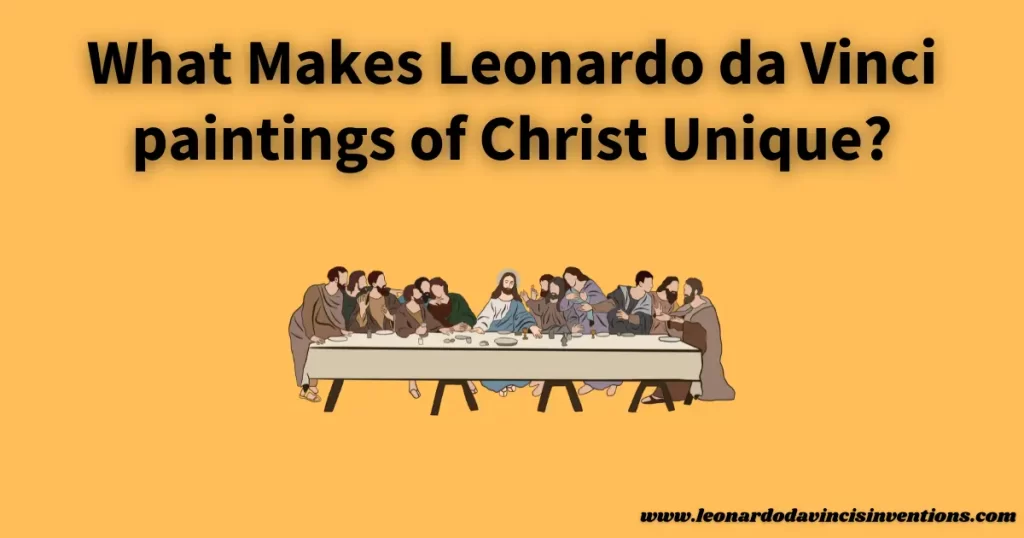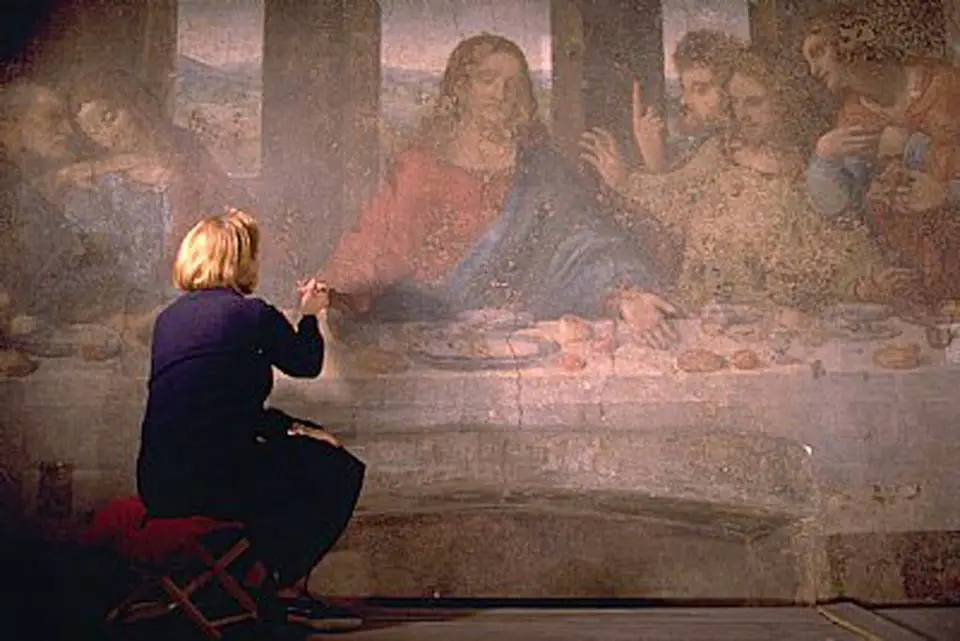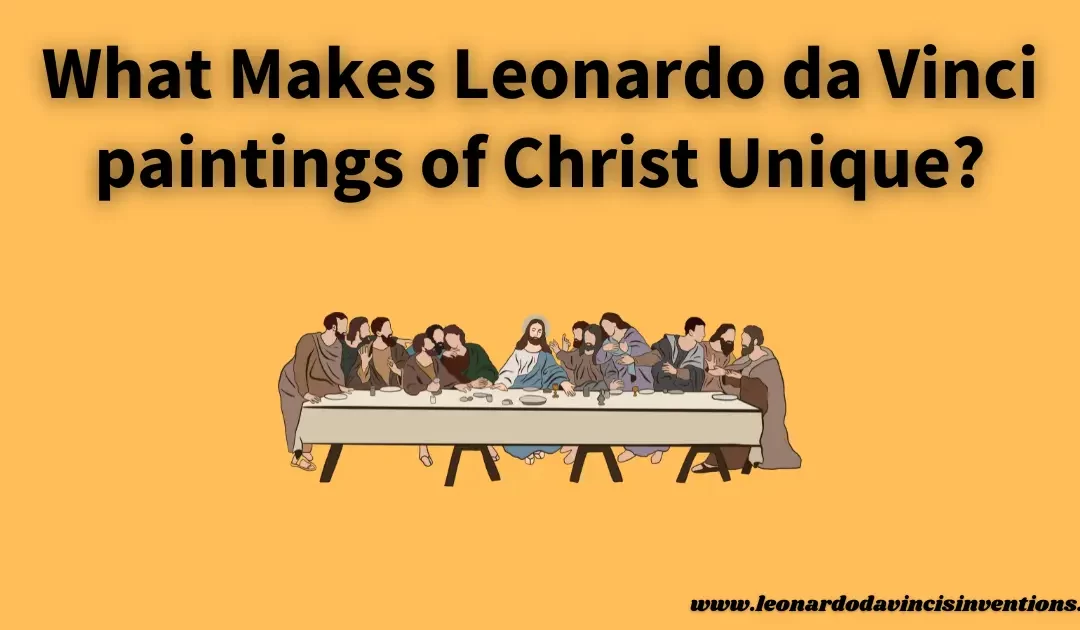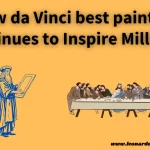
Leonardo da Vinci paintings of Christ often leave people wondering what makes them stand apart from works by other artists.
His art stands out because he combines detailed human emotion, creative composition, and deep symbolism in each scene he paints.
If you want to discover why masterpieces like The Last Supper or Salvator Mundi are so famous, this article will help you see Leonardo’s skill with new eyes.
These paintings capture more than just religious stories.
They invite you to notice the feelings and hidden meanings in every brushstroke.
When exploring da Vinci’s approach, you might find surprising details, such as his use of color and unusual painting techniques that make his biblical images memorable.
The Historical and Religious Context of Leonardo da Vinci Paintings of Christ
Leonardo da Vinci’s paintings of Christ reflect the religious atmosphere of late fifteenth-century Europe.
He blended Christian iconography with human emotion and artistic innovation, developing a visual style that made these religious paintings enduring icons in Western art.
The Significance of the Last Supper in Renaissance Art
The Last Supper is one of the most important artistic masterpieces of the Renaissance.
Painted between 1494 and 1498 in Milan, this fresco marks a breakthrough in technical skill and religious storytelling.
Leonardo captured the exact moment when Jesus Christ announced the betrayal by Judas Iscariot, putting dramatic tension at the heart of the scene.
Leonardo’s perspective pulls viewers into the moment, making the Twelve Apostles and Christ feel present and real.
Each apostle reacts differently, showing a range of emotions from shock to sorrow.
The layout and seating arrangement tell the Biblical narrative visually clearly.
Depicting Jesus Christ and the Twelve Apostles with Spiritual Devotion
Leonardo showed spiritual devotion in representing Jesus Christ and the Twelve Apostles.
Instead of stiff poses, he painted lifelike gestures and mysterious expressions.
The artist believed that body language and facial features reveal inner thoughts and faith, which is why every disciple in the Last Supper looks unique.
In the painting, Jesus is placed at the center, with light and shadow drawing attention to his calm presence.
The grouping of the apostles in three sets reflects unity and balance in composition.
Leonardo’s technique heightened the spiritual intensity through these choices and deepened the narrative.
By mixing drama and emotion, he made a religious painting that feels alive and meaningful for viewers.
Understanding the Biblical Narrative and Sacred Themes
Leonardo based many of his religious paintings on sacred themes found in the Bible.
The story of the Last Supper, where Jesus Christ dines with his followers before his arrest, is grounded in the Gospel narrative.
In his works, like The Baptism of Christ and The Annunciation, he used visual symbolism and composition to tell these sacred stories clearly and powerfully.
Leonardo’s attention to storytelling is evident in how he captured the moment of betrayal and the apostles’ reactions.
By focusing on human emotion and relationships, he made the Biblical narrative accessible and vivid.
His paintings of Christ, such as those with the Virgin Mary and the Christ Child, emphasized the divinity and humanity of the figures, making them meaningful for both his time and today.
The Role of Milan and the Gospel of John in Da Vinci’s Work
Milan played a significant role in Leonardo’s career during the Renaissance, providing resources and support from wealthy patrons.
He painted the Last Supper fresco in Milan, which still draws visitors and scholars worldwide.
This city was also a center for religious thought, inspiring Leonardo to engage deeply with Christian themes.
The Gospel of John influenced the content and feeling of his paintings of Christ.
John’s Gospel provided the story setting for the Last Supper, emphasizing love, betrayal, and Jesus’s sacrifice.
These themes helped Leonardo focus on pivotal moments and emotional depth in his work, connecting Renaissance art with biblical tradition.
Religious Symbolism and Christian Iconography in Da Vinci’s Paintings
Religious symbolism and Christian iconography fill Leonardo da Vinci’s paintings of Christ.
Common symbols include using light as a sign of divinity, placing hands to show blessing or betrayal, and geometric compositions like the pyramidal balance seen in the Virgin and Christ Child paintings.
These methods brought layered meanings to each scene.
Leonardo also used elements like the halo, bread, and wine to connect his art with Christian rituals and beliefs.
The arrangement of figures, their gestures, and even background architecture reinforced theology and history for his viewers.
His focus on artistic innovation made these symbols accessible and visually striking.
Combining deep spiritual meaning and visual storytelling sets Da Vinci’s religious paintings apart as foundational works in Western art and religious symbolism.
Artistic Innovation and Techniques in Leonardo da Vinci Paintings of Christ

Leonardo da Vinci paintings of Christ stand out for their creative approaches to composition, use of light, and emotional storytelling.
His works left a lasting effect on Western art by advancing religious painting with new artistic innovation and a focus on human emotion.
Mastering Fresco: The Last Supper Fresco and Its Restoration
The Last Supper fresco, painted in the late 1490s in Milan, showcases da Vinci’s skill and experimentation with technique.
Instead of following the typical method for fresco painting, he tried an oil and tempera mix on dry plaster.
This gave richer colors but made the artwork more vulnerable to damage.
Over the centuries, The Last Supper suffered from flaking and fading.
Pollution, humidity, and war damage forced continuous efforts at painting restoration.
Recent restorations attempted to preserve what remains of da Vinci’s original brushwork.
Leonardo da Vinci Technique: Use of Perspective and Light and Shadow
Leonardo da Vinci revolutionized religious painting by using linear perspective to create depth.
In The Last Supper, all the perspective lines draw the viewer’s attention to Jesus Christ, highlighting his central role in the biblical narrative.
This structure carefully guides the eyes and adds balance to the composition.
He also applied sfumato and chiaroscuro, advanced methods for blending light and shadow.
These subtle gradations made figures more lifelike and dynamic.
The warm and cool areas shape the faces and hands, drawing out human emotion in art.
His mastery of light and space became a defining part of Renaissance art.
Pyramidal Composition and Composition Balance in Religious Painting
Pyramidal composition is clear in several Leonardo da Vinci paintings of Christ, including those featuring the Virgin Mary, the Christ Child, and sometimes the Infant John the Baptist or an Archangel.
The figures are often arranged in triangular groupings, which create a sense of harmony and spiritual devotion.
This balanced structure anchored the religious symbolism and helped visually tell the Gospel of John or other Biblical stories.
Whether in The Last Supper or the Adoration of the Magi, each person’s position and gesture served a purpose in the broader composition.
The approach also influenced generations of later Western art.
Mysterious Expressions, Drama, and Emotion in Depicting Betrayal
Da Vinci’s genius shines in his ability to capture mysterious expressions during dramatic moments.
In The Last Supper, he paints the Twelve Apostles when Christ announces the Betrayal by Judas Iscariot.
The reaction of each figure is different, revealing tension, shock, and sadness.
He avoided exaggerated dramatic poses, instead displaying subtle shifts in expression and gesture.
This realism allowed viewers to sense the intense drama and emotion embedded in the biblical narrative.
Such techniques became iconic in artistic masterpieces and set new standards for Christian iconography.
The Integration of Symbolism and Human Emotion in Art
Symbolism is woven throughout Leonardo da Vinci paintings of Christ.
He used objects, gestures, and even how light falls on each figure to reinforce sacred themes.
For example, in The Last Supper, Jesus is framed by the window behind him, suggesting a halo and spiritual significance.
Leonardo did not separate religious symbolism from human emotion.
He made the characters relatable so viewers could connect with the human side of events, like the Adoration or the betrayal declaration.
These choices deepened the spiritual message and considered the historical context of each biblical event.
The Enduring Legacy of Leonardo da Vinci Paintings of Christ
Leonardo da Vinci Paintings of Christ have changed how artists, scholars, and believers view Christian art.
These works are admired for their artistic innovation, deep symbolism, and influence on both religious painting and Western art.
The Artistic Masterpiece Status of The Last Supper and Other Works
Leonardo da Vinci’s The Last Supper is an iconic work of art and one of the most recognized fresco paintings in history.
Painted in Milan between 1495 and 1498, this masterpiece uses perspective and composition to draw attention to Jesus Christ at the scene’s center.
Leonardo uses light and shadow to focus viewers’ attention and create a sense of drama and emotion among the Twelve Apostles.
The work’s technical challenges, especially the choice of materials, required several painting restorations over the centuries.
The Last Supper helped set new religious storytelling standards, attracting visitors and experts worldwide.
Depicting Iconic Figures: Virgin Mary, Christ Child, Infant John the Baptist, and Archangel
Leonardo’s religious paintings often include the Virgin Mary, Christ the King, Infant John the Baptist, and sometimes an Archangel. They show his skill at expressing sacred themes through realistic figures.
Works like the Baptism of Christ and Madonna of the Rocks use pyramidal composition and detailed human emotion in art. Instead of making holy figures distant or abstract, Leonardo gives them gentle, mysterious expressions and natural gestures.
This approach brings a sense of closeness and humanity. These biblical characters become relatable to viewers.
He uses Christian iconography to blend Renaissance art techniques with spiritual devotion. Many artists after him followed his influence.
The Betrayal Declaration and the Role of Judas Iscariot in Art History
Leonardo’s painting The Last Supper shows Jesus declaring betrayal when he says one disciple will betray him. Judas Iscariot’s reaction in the painting stands out for its placement and expressive detail.
Leonardo places Judas on the same side of the table as Jesus and the other Apostles, which increases tension and draws viewers into the biblical story.
This moment highlights da Vinci’s skill in capturing drama and emotion. His approach shapes how later generations see Judas’s role in art history.
Religious Storytelling and Spiritual Devotion Through Da Vinci’s Genius
Leonardo uses light, gesture, and setting to bring biblical stories to life. He inspires viewers’ spiritual devotion through his art.
His scenes do more than tell a story. They reveal human feeling and deep religious symbolism.
Leonardo’s technique focuses on subtle facial expressions, body language, and balanced composition. This method makes viewers feel like witnesses to the Gospel of John or other scriptural moments.
How Leonardo da Vinci Paintings of Christ Influenced Western Art and Artistic Legacy
Leonardo da Vinci’s religious paintings changed the future of Western art. He used perspective, detailed human anatomy, and symbolic touches as guides for later painters.
His innovations moved religious painting away from stiff, flat traditions. By combining artistic mastery with spiritual meaning, da Vinci expanded the possibilities of Christian art.
Generations of artists study his technique and try to capture the same sense of drama and spiritual depth. His paintings of Christ remain a central part of his artistic legacy and continue to inspire today’s art world.
Frequently Asked Questions
Leonardo da Vinci created several paintings of Christ. His unique interpretations stand out even among other Renaissance artists.
His work includes famous pieces that have sparked conversations about art, faith, and history.
Did Leonardo da Vinci paint Jesus?
Leonardo da Vinci never met Jesus, so he did not paint a real-life portrait. He painted images of Jesus based on religious texts and artistic traditions of his time.
His most well-known works featuring Christ are “The Last Supper” and “Salvator Mundi”.
Did Leonardo da Vinci believe in Christ?
There is little concrete evidence about Leonardo’s religious beliefs. Although he grew up in a Catholic society, some scholars think he questioned traditional teachings.
He still painted several religious scenes, including those featuring Christ, for patrons and churches.
Which Leonardo da Vinci painting of Jesus Christ sold for $450 million?
The painting “Salvator Mundi” by Leonardo da Vinci sold for $450 million at auction. This piece shows Jesus making a gesture of blessing and holding a crystal orb.
It became the most expensive painting ever sold at that time. More details about Salvator Mundi can be found here.
Who was the model for Leonardo da Vinci’s painting of Jesus?
The actual model for Jesus in Leonardo’s paintings is not known. Renaissance artists often used male models from their studio or community.
No historical record identifies a specific individual as the model for Christ in Leonardo’s paintings.
Who is the famous painting of Jesus?
The most famous painting of Jesus by Leonardo da Vinci is “The Last Supper.” This mural shows Jesus with his twelve apostles when he reveals that one will betray him.
Another well-known painting is “Salvator Mundi”, portraying Jesus Christ.
Did Leonardo da Vinci paint Mary Magdalene?
Leonardo did not create a portrait known as “Mary Magdalene.” In “The Last Supper,” some speculate about the figure’s identity as being in Jesus’s right, but art historians agree that this figure is John the Apostle.
There is no verified da Vinci painting of Mary Magdalene.
Did anyone ever paint a picture of Jesus?
Many artists across history have painted images of Jesus Christ. Leonardo da Vinci is one of the most recognized, but others include Michelangelo, Raphael, and El Greco.
Early images were based on stories from the Bible and ideas about Jesus’s appearance.
Why did Da Vinci paint the Last Supper?
Leonardo painted “The Last Supper” as a commission for Milan’s Santa Maria delle Grazie dining hall. The mural shows the dramatic moment when Jesus tells the apostles one of them will betray him.
The painting stands out for its emotion and attention to detail.
Who is the artist who painted Jesus?
Leonardo da Vinci painted Jesus in several works, most famously in “The Last Supper” and “Salvator Mundi”. He is known for his careful study of human emotion and anatomy, which shows in his religious paintings.
Many other artists have also painted Jesus throughout history.
Why is Salvator Mundi so controversial?
“Salvator Mundi” is controversial because some scholars question whether Leonardo painted it entirely himself. Restoration work and the painting’s long-lost status have caused debates over its authenticity.
Many people still recognize it as an important work related to Leonardo’s paintings of Christ.




 Leonardo Bianchi,
the creator of Leonardo da Vinci's Inventions.
Thank you for visiting
Leonardo Bianchi,
the creator of Leonardo da Vinci's Inventions.
Thank you for visiting